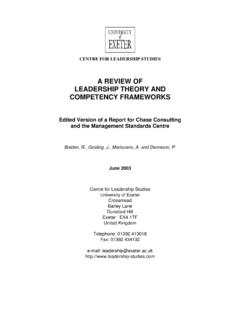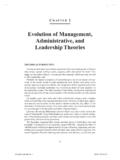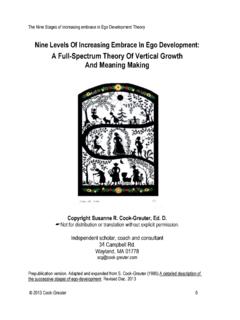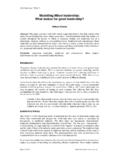Transcription of The Theory Behind the Practice
1 The Theory Behind the PracticeA Brief Introduction to the Adaptive leadership FrameworkExcerpted fromThe Practice of Adaptive leadership : Tools and Tactics for Changing Your Organization and the WorldByRonald Heifetz, Alexander Grashow, and Marty LinskyBuy the book:AmazonBarnes & Business PressBoston, MassachusettsISBN-13: 978-1-4221-3240-13241 BCCopyright 2009 Harvard Business School Publishing CorporationAll rights reservedPrinted in the United States of AmericaThis chapter was originally published as chapter 2 of The Practice of Adaptive leadership .
2 Tools and Tactics for Changing Your Organization and the World,copyright 2009 Cambridge leadership part of this publication may be reproduced, stored in or introduced into a retrieval system,or transmitted, in any form, or by any means (electronic, mechanical, photocopying,recording, or otherwise), without the prior permission of the publisher. Requests for permission should be directed to or mailed to Permissions,Harvard Business School Publishing, 60 Harvard Way, Boston, Massachusetts can purchase Harvard Business Press books at booksellers worldwide.
3 You can order HarvardBusiness Press books and book chapters online at ,or by calling 888-500-1016 or, outside the and Canada, 617-783-7410. |CHAPTER 2|The Theory Behindthe PracticeSINCE 1994, ADAPTIVE leadership has been advanced andexplored in a series of other books in addition to leadership With-out Easy Answersand leadership on the burgeoning litera-ture in this emerging field includes the work of our colleagues SharonDaloz Parks, in LeadershipCanBe Taught, and Dean Williams, in books have applied the adaptive leadership frame-work to the challenges in specific professional contexts.
4 These includeRichard Foster and Sarah Kaplan s Creative Destructionand Donald s The Real Work of Leaderson applications to big businesses;Gary De Carolis s A View from the Balconyon systems of care; StacieGoffin and Valora Washington s Ready or Noton early childhood edu-cation; Shifra Bronznick, Didi Goldenhar, and Marty Linsky s Levelingthe Playing Fieldon women in Jewish organizational life; and KevinFord s Transforming Church: Bringing Out the Good to Get to Greatonthe challenges facing American work grows from efforts to understand in practical ways therelationship among leadership , adaptation, systems, and change, butalso has deep roots in scientific efforts to explain the evolution ofhuman life, and before us, the evolution of all life going back to thebeginning of the nearly 4 million years, our early ancestors lived in small bandsthat foraged for food.
5 They developed ever-increasing sophisticationin the design of tools and strategies for hunting and movement; andtheir physical capacity grew as they developed ways, through evolu-tionary change, to increase their range. Drawing on what anthropolo-gists and psychologists have identified as our capacity to internalizethe wisdom of elders, the first humans went on to form cultures withself-sustaining norms that required minimal reinforcement by authori-ties. Cultural norms gave human beings remarkable adaptability andscalability when, quite recently, about twelve thousand years ago,people learned to domesticate plants and animals, and their new abilityto store food allowed and required sustained settlements.
6 Large num-bers of people living together brought new needs for governing largeorganizations and early ancestors process of adaptation to new possibilities andchallenges has continued over the course of written history with thegrowth and variation in scope, structure, governance, strategy, and coor-dination of political and commercial enterprise. So has the evolution inunderstanding the Practice of managing those processes, including inour lifetimes what we call adaptive leadership is the Practice of mobilizing people to tackle toughchallenges and concept of thrivingis drawn from evolution-ary biology, in which a successful adaptation has three characteristics:(1) it preserves the DNA essential for the species continued survival;(2) it discards (reregulates or rearranges) the DNA that no longerserves the species current needs.
7 And (3) it creates DNA arrangementsthat give the species the ability to flourish in new ways and in morechallenging environments. Successful adaptations enable a living sys-tem to take the best from its history into the does this suggest as an analogy for adaptive leadership ? Adaptive leadership is specifically about change that enables thecapacity to environments and new dreams demandnew strategies and abilities, as well as the leadership to mobilizethem. As in evolution, these new combinations and variationshelp organizations thrive under challenging circumstancesrather than perish, regress, or contract.
8 leadership , then, mustwrestle with normative questions of value, purpose, and does thrivingmean for organizations operating in anyparticular context?2 Introduction: Purpose and PossibilityThe Theory Behind the Practice3In biology, thriving means propagating. But in business, forexample, signs of thriving include increases in short- and long-term shareholder value, exceptional customer service, highworkforce morale, and positive social and environmental adaptive success in an organizational sense requires leader-ship that can orchestrate multiple stakeholder priorities to definethriving and then realize it.
9 Successful adaptive changes build on the past rather than biological adaptations, though DNA changes may radicallyexpand the species capacity to thrive, the actual amountof DNAthat changes is minuscule. More than 98 percent of our currentDNA is the same as that of a chimpanzee: it took less than a 2 per-cent change of our evolutionary predecessors genetic blueprintto give humans extraordinary range and ability. A challenge foradaptive leadership , then, is to engage people in distinguishingwhat is essential to preserve from their organization s heritagefrom what is expendable.
10 Successful adaptations are thus bothconservative andprogressive. They make the best possible use ofprevious wisdom and know-how. The most effective leadershipanchors change in the values, competencies, and strategic orien-tations that should endure in the organization. Organizational adaptation occurs through , sexual reproduction is an experiment: it rapidly producesvariations along with high failure rates. As many as one-third ofall pregnancies spontaneously miscarry, usually within the firstweeks of conception, because the embryo s genetic variation istoo radical to support life.







